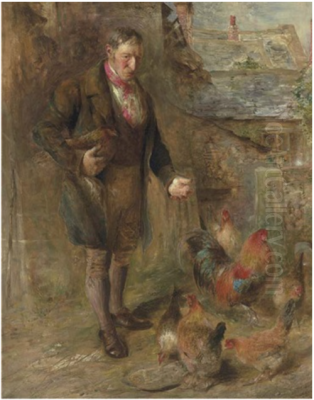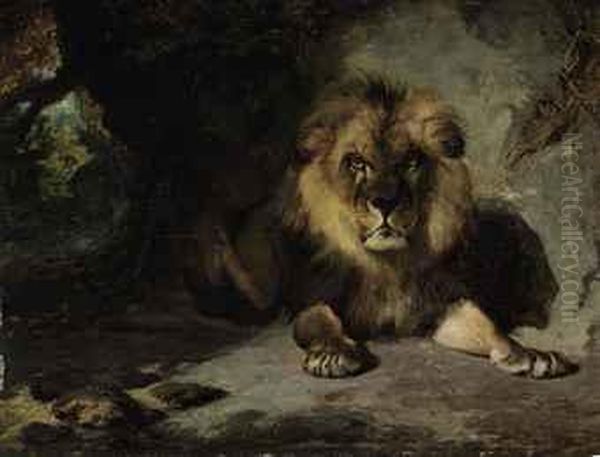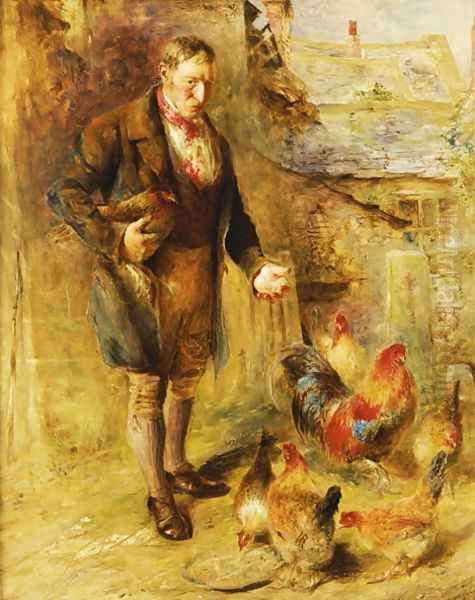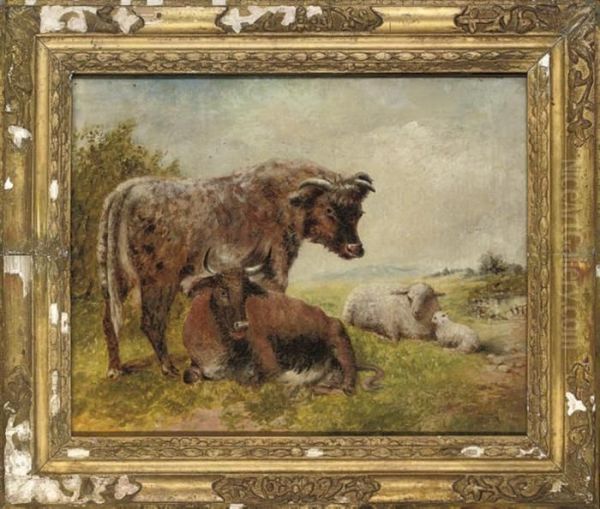
William Huggins stands as a distinctive figure in the landscape of nineteenth-century British art. Born in Liverpool in 1820 and passing away near Chester in 1884, Huggins carved a unique niche for himself primarily as a painter of animals, though his oeuvre also encompassed portraits and, later in life, landscapes. Often associated with the Liverpool School of painters, his meticulous technique, intense observation, and preference for specific materials set him apart from many contemporaries, including the era's dominant animal painter, Sir Edwin Landseer. His life and work offer a fascinating glimpse into the regional artistic currents of Victorian England and the enduring appeal of animal subjects rendered with both accuracy and character. It is crucial, however, to distinguish this William Huggins, the artist, from his near-contemporary, Sir William Huggins (1824-1910), the pioneering astronomer, with whom he is sometimes confused due to the shared name and overlapping period.
Early Life and Artistic Formation in Liverpool
William Huggins was born into the bustling maritime city of Liverpool on May 30, 1820. His early artistic inclinations were nurtured, and he received formal training at the Liverpool Mechanics' Institution, where he won an award for drawing at a young age. This foundational education likely provided him with essential skills, but much of Huggins's artistic development seems to have been self-directed, driven by an intense fascination with the natural world, particularly animals.
Liverpool itself provided a rich environment for the budding artist. As a major port city, it was a hub of activity and commerce, and it also boasted cultural institutions. Crucially for Huggins, Liverpool had Zoological Gardens, and the city was frequently visited by travelling menageries, such as the famous Wombwell's. Huggins became a dedicated observer at these locations, spending countless hours sketching animals directly from life. This practice honed his understanding of animal anatomy, posture, and behaviour, forming the bedrock of his artistic practice.

His dedication to direct observation was profound. Unlike artists who might rely more heavily on prints or imagination, Huggins grounded his work in empirical study. This commitment to accuracy became a hallmark of his style, lending his animal depictions a sense of realism and vitality that resonated with viewers who appreciated naturalistic representation. This early immersion in the animal world, facilitated by Liverpool's resources, was fundamental to shaping his artistic identity.
The Influence of Stubbs and the Development of a Unique Style
From early in his career, comparisons were drawn between William Huggins and the pre-eminent British animal painter of the eighteenth century, George Stubbs. Like Stubbs, Huggins demonstrated a profound interest in animal anatomy and a commitment to accurate portrayal. Stubbs, famed for works like Whistlejacket, had set a high bar for anatomical precision, often based on dissection. While it's unclear if Huggins undertook similar studies, his finished paintings reveal a comparable dedication to rendering the structure, musculature, and characteristic stance of his subjects.
However, Huggins was no mere imitator. He developed a highly individual technique that contributed significantly to the distinctive look of his paintings. He frequently chose to work not on conventional canvas but on smooth, white-painted millboard or wooden panels. This bright, reflective ground allowed him to achieve a remarkable luminosity and clarity in his colours.
He would often build up his images using thin glazes of colour over meticulous underdrawing, allowing the white ground to shine through, particularly in highlights. This technique resulted in paintings with a smooth, almost enamel-like finish, sharp details, and a cool, clear light that differed markedly from the often warmer, more heavily textured surfaces seen in the work of many contemporaries. This technical approach, combined with his observational skills, defined his unique contribution to animal painting.
Subjects: From Farmyard to Exotic Beasts
Huggins's subject matter was diverse, though consistently centred on the animal kingdom. He excelled in depicting familiar domestic animals, particularly horses, cattle, donkeys, and poultry. Farmyard scenes were a recurring theme, allowing him to group various animals together and showcase his skill in rendering different textures – the sleek coat of a horse, the rough hide of a donkey, the soft feathers of a chicken. Works like Horses and Poultry or Donkeys and Poultry in a Farmyard exemplify this aspect of his output.

His interest extended beyond the barnyard to more exotic creatures, fuelled by his studies at the Liverpool Zoological Gardens and travelling menageries. Lions, tigers, and other large cats featured in his work, often depicted with a quiet intensity rather than overt ferocity. He seemed less interested in dramatic narratives and more focused on capturing the inherent presence and form of the animals themselves. Titles like Lions in a Den suggest these subjects, rendered with the same careful observation he applied to domestic animals.
He also undertook portraiture, sometimes incorporating animals, as seen in paintings featuring sitters with their horses or dogs. A notable example is his own Self-Portrait, which presents a confident image of the artist. While animals remained his primary focus, these portraits demonstrate his versatility and skill in capturing human likeness as well. Throughout his career, his approach remained rooted in careful observation and detailed execution, regardless of the specific subject.
Exhibition Career and the Liverpool Academy
Huggins began exhibiting early in his career, primarily at the Liverpool Academy of Arts. He became an associate member in 1847 and a full member in 1850. The Academy was the main forum for artists in the city, and Huggins quickly established a strong reputation there, winning the Academy's painting prize in 1854. His detailed, luminous works stood out and garnered significant local appreciation.
He also sought recognition on the national stage, sending works to the major London exhibitions, including the Royal Academy, the British Institution, and the Society of British Artists. While his paintings were accepted and shown – he exhibited regularly at the Royal Academy in London from 1842 until shortly before his death – he never achieved the same level of fame or official recognition in the capital as he enjoyed in Liverpool. He was never elected to the Royal Academy, a fact sometimes attributed to his provincial base and perhaps his somewhat eccentric personality and refusal to compromise his distinct style.
His relationship with the Liverpool Academy itself grew strained over time. Disagreements arose, particularly concerning the Academy's increasing alignment with the Pre-Raphaelite Brotherhood, a movement whose aesthetic differed significantly from Huggins's own precise, smooth finish, despite a shared emphasis on detailed observation. Artists like William Holman Hunt and John Everett Millais were championed by some factions within the Academy. Huggins, along with several other established members, resigned from the Academy in the mid-1850s in protest against these developments, highlighting the artistic tensions of the period.
Huggins and the Liverpool School

William Huggins is considered a key figure within the Liverpool School, a term used to describe the group of artists active in the city during the mid-nineteenth century. While not a formally organised movement with a strict manifesto, the Liverpool School artists shared certain characteristics, including a strong connection to their local environment and often a detailed, naturalistic approach influenced partly by the Pre-Raphaelites, even if individual styles varied greatly.
Huggins's meticulous detail and bright palette resonated with some aspects of Pre-Raphaelitism, particularly the emphasis on truth to nature. However, his smooth finish and classical compositional sense, often reminiscent of George Stubbs, distinguished him from the more radical stylistic innovations of core Pre-Raphaelites like Dante Gabriel Rossetti or the intense, detailed landscapes of Liverpool contemporaries such as William Davis.
Other notable artists associated with the Liverpool School include Robert Tonge, known for his atmospheric landscapes, John Wright Oakes, who also painted landscapes, particularly Welsh scenes, and Daniel Alexander Williamson, whose later work embraced a more visionary, light-filled aesthetic. Richard Ansdell, another Liverpool-born artist who achieved greater national fame, also specialized in animal painting but often incorporated more narrative and Scottish Highland themes, differing from Huggins's more focused animal studies. Huggins's unique style and dedication to animal subjects made him a distinct, if somewhat independent, pillar of the Liverpool art scene during this vibrant period.
A Contrast: Huggins and Sir Edwin Landseer
No discussion of Victorian animal painting is complete without mentioning Sir Edwin Landseer, the era's most celebrated practitioner in the genre. Landseer's works, such as The Monarch of the Glen or Dignity and Impudence, were immensely popular, widely reproduced as engravings, and earned him royal patronage and immense fame. Comparing Huggins with Landseer highlights the different paths available within animal art during this period.
Landseer was a master storyteller, often imbuing his animal subjects with human-like emotions and placing them in dramatic or sentimental narratives. His technique was typically broader and more painterly than Huggins's, with visible brushwork and a focus on capturing texture and atmosphere, often with a warmer palette. His work appealed directly to Victorian sensibilities, blending technical skill with pathos and anecdote.
Huggins, in contrast, generally avoided overt anthropomorphism or complex narratives. His focus remained steadfastly on the animal itself – its structure, its presence, its specific characteristics. His approach was more objective, analytical, and perhaps less concerned with eliciting an emotional response than with presenting an accurate and beautifully rendered study. His cool, luminous technique, reliant on the white ground, also differed significantly from Landseer's richer, more conventional oil painting methods. While Landseer dominated the London art scene and the popular imagination, Huggins maintained his unique vision, appreciated by those who valued his precision, clarity, and less sentimental approach to the animal world.
Later Life: Chester, Wales, and Landscapes
In 1861, Huggins left his native Liverpool and moved to Chester, a historic city nearby. This move perhaps reflected his disillusionment following the disputes at the Liverpool Academy or simply a desire for a change of scene. He continued to paint, maintaining his focus on animal subjects. His reputation was well-established, and he continued to exhibit, though perhaps less prolifically than before.
Later, in 1876, he moved again, this time to Betws-y-Coed in North Wales. This area was a popular destination for artists, drawn by its dramatic mountain scenery and picturesque landscapes. During this period, Huggins began to paint more landscapes, although animals often still featured within them. A work like The Fairy Glen, depicting a well-known Welsh beauty spot, dates from this later phase of his career. These landscapes retained his characteristic attention to detail but explored different compositional challenges and effects of light.
Despite these excursions into landscape, animal painting remained central to his identity. Anecdotes suggest he maintained his eccentric connection to the animal world, sometimes keeping unusual pets. He eventually returned from Wales to the Chester area, settling in the village of Christleton. It was here that he passed away on February 25, 1884, leaving behind a substantial body of work dedicated primarily to the celebration of animal life through his unique artistic lens.
Technique Revisited: The Luminous Panel
The technical distinctiveness of William Huggins's work warrants further emphasis. His preference for painting on a prepared white ground, usually on millboard or panel, was fundamental to the visual impact of his art. This practice diverged from the more common use of canvas, often prepared with darker or neutral grounds, favoured by many contemporaries.
The smooth, hard surface of the panel allowed for extremely fine detail and precise drawing, which Huggins executed with great skill. The brilliant white ground, reflecting light back through the subsequent layers of paint, imparted a unique luminosity and coolness to his colours. He often applied paint in thin, transparent glazes, allowing the underlying drawing and the ground itself to contribute to the final effect. This meticulous, layered approach created a smooth, almost porcelain-like finish, quite different from the textured impasto or visible brushwork seen in other styles of the period.
This technique was particularly effective for rendering the sleek coats of horses, the intricate patterns of feathers, or the subtle modelling of musculature under skin. It gave his work clarity and brilliance, setting it apart visually. While perhaps labour-intensive, this method was integral to Huggins's artistic vision, enabling him to achieve the high degree of precision and distinctive light that characterized his best paintings. His mastery of this technique is a key aspect of his contribution to British art.
Legacy and Art Historical Position
William Huggins occupies a significant, if sometimes overlooked, position in British art history. He was undoubtedly one of the foremost animal painters of the Victorian era, particularly associated with the thriving art scene of Liverpool. His work stands as a testament to the high level of technical skill and artistic ambition present outside the London metropolis during the nineteenth century.
His legacy is primarily tied to his animal paintings. His dedication to anatomical accuracy, influenced by George Stubbs but pursued with his own distinct methods, produced works of lasting quality and appeal. His unique technique, using luminous white grounds, gives his paintings a recognisable and often striking appearance. While he never achieved the widespread fame of Landseer, his work was appreciated by collectors and critics who valued his precision and unsentimental observation.
In the broader context of Victorian art, Huggins represents a particular strand of realism focused on the natural world. While contemporaries like the Pre-Raphaelites pursued detailed realism often in the service of narrative or symbolism, and others like George Frederic Watts or Frederic Leighton explored grander historical or allegorical themes, Huggins remained dedicated to the careful depiction of animals. He can be seen alongside other skilled animal painters like Briton Rivière, who also often depicted animals (especially lions) but frequently with more narrative intent. Huggins's contribution lies in his focused, almost scientific yet aesthetically refined approach to animal portraiture. Today, his works are held in major public collections, particularly in Liverpool (Walker Art Gallery) and Chester (Grosvenor Museum), ensuring his distinctive vision remains accessible.
Conclusion: An Enduring Vision
William Huggins of Liverpool navigated the Victorian art world with a singular vision. Rooted in the meticulous observation of the animal kingdom and executed with a unique and luminous technique, his paintings offer a distinct alternative to the more narrative or sentimental approaches of some contemporaries. From the farmyards and menageries of his youth to the landscapes of his later years, his commitment to capturing the form and presence of his subjects remained constant. Though perhaps overshadowed on the national stage by figures like Landseer, Huggins's status as a master of animal painting, particularly within the context of the Liverpool School, is secure. His work continues to be admired for its technical brilliance, clarity of observation, and the quiet dignity it imparts to the creatures he so carefully depicted, securing his place as a noteworthy and individual talent in the rich tapestry of nineteenth-century British art.